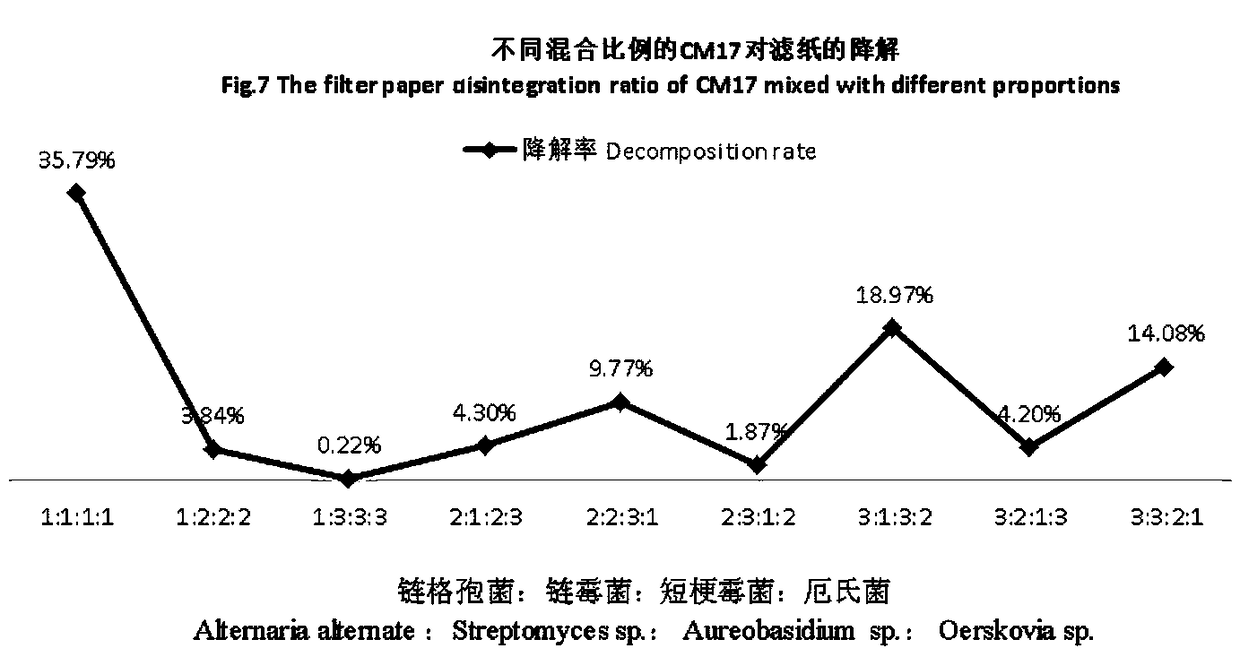Cellulose degrading bacteria compound system
A technology of cellulose-degrading bacteria and sodium carboxymethyl cellulose, applied in the field of microorganisms, can solve the problems of cellulose-degrading effects, inactivation of degrading bacteria, unfavorable combination of bacteria, etc., achieve optimal cellulose-degrading function, eliminate antagonism, Effect of improving cellulose degradation efficiency
- Summary
- Abstract
- Description
- Claims
- Application Information
AI Technical Summary
Problems solved by technology
Method used
Image
Examples
Embodiment 1
[0025] A compound strain of cellulose-degrading bacteria, including Alternaria, Streptomyces, Erchetia and Aureobasidium, the ratio of which is 1:1:1:1.
[0026] The preparation method of the above-mentioned cellulose-degrading bacteria composite system comprises the following steps:
[0027] (1) Extraction of complex bacterial strains: Collect humus from Yu'an Mountain in the western suburbs of Kunming, bottom mud of Dianchi Lake in Kunming, excrement around toilets, and cow dung in Dali, and isolate Alternaria, Streptomyces, Erchetia and Brachyphyllum from them After mold, store at low temperature;
[0028] (2) Preparation of medium: 3 g of peptone, 2 g of ammonium sulfate, 0.5 g of yeast extract, KH 2 PO 4 4g, CaCl 2 ·2H 2 O0.3g, MgSO 4 ·7H 2 O 0.3g, Tween-800.2mL, CMC 20g, distilled water 1000mL, after mixing evenly, sterilize at 125°C for 15min to obtain carboxymethylcellulose sodium liquid fermentation medium.
[0029] (3) The four kinds of bacterial strains are ...
Embodiment 2
[0032] A compound strain of cellulose-degrading bacteria, including Alternaria, Streptomyces, Erchetia and Aureobasidium, the ratio of which is 1:1:1:1.
[0033] The preparation method of the above-mentioned cellulose-degrading bacteria composite system comprises the following steps:
[0034] (1) Extraction of complex bacterial strains: Collect humus from Yu'an Mountain in the western suburbs of Kunming, bottom mud of Dianchi Lake in Kunming, excrement around toilets, and cow dung in Dali, and isolate Alternaria, Streptomyces, Erchetia and Brachyphyllum from them After mold, store at low temperature;
[0035] (2) Preparation of medium: 3 g of peptone, 2 g of ammonium sulfate, 0.5 g of yeast extract, KH 2 PO 4 4g, CaCl 2 ·2H 2 O0.3g, MgSO 4 ·7H 2 O 0.3g, Tween-800.2mL, CMC 20g, distilled water 1000mL, after mixing evenly, sterilize at 115°C for 25min to obtain carboxymethylcellulose sodium liquid fermentation medium.
[0036] (3) The four kinds of bacterial strains are ...
Embodiment 3
[0039] A compound strain of cellulose-degrading bacteria, including Alternaria, Streptomyces, Erchetia and Aureobasidium, the ratio of which is 1:1:1:1.
[0040] The preparation method of the above-mentioned cellulose-degrading bacteria composite system comprises the following steps:
[0041] (1) Extraction of complex bacterial strains: Collect humus from Yu'an Mountain in the western suburbs of Kunming, bottom mud of Dianchi Lake in Kunming, excrement around toilets, and cow dung in Dali, and isolate Alternaria, Streptomyces, Erchetia and Brachyphyllum from them After mold, store at low temperature;
[0042] (2) Preparation of medium: 3 g of peptone, 2 g of ammonium sulfate, 0.5 g of yeast extract, KH 2 PO 4 4g, CaCl 2 ·2H 2 O0.3g, MgSO 4 ·7H 2 O 0.3g, Tween-800.2mL, CMC 20g, distilled water 1000mL, after mixing evenly, sterilize at 120°C for 20min to obtain carboxymethylcellulose sodium liquid fermentation medium.
[0043] (3) The four kinds of bacterial strains are ...
PUM
 Login to View More
Login to View More Abstract
Description
Claims
Application Information
 Login to View More
Login to View More - R&D
- Intellectual Property
- Life Sciences
- Materials
- Tech Scout
- Unparalleled Data Quality
- Higher Quality Content
- 60% Fewer Hallucinations
Browse by: Latest US Patents, China's latest patents, Technical Efficacy Thesaurus, Application Domain, Technology Topic, Popular Technical Reports.
© 2025 PatSnap. All rights reserved.Legal|Privacy policy|Modern Slavery Act Transparency Statement|Sitemap|About US| Contact US: help@patsnap.com



